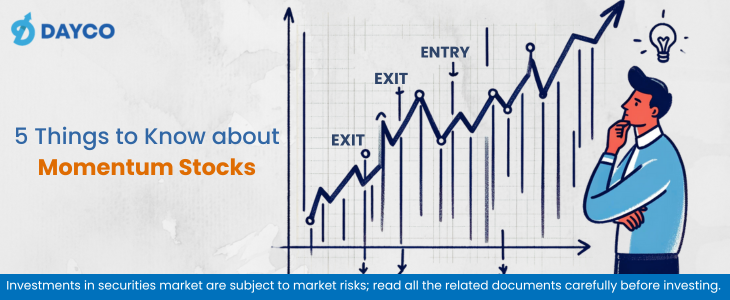Momentum is a concept that would excite every trader, isn’t it? Stocks with significant momentum depict strong price movements and help traders decide their course of action. So, if you are looking for momentum stocks, this article is just for you. Here, you will learn about momentum stocks, strategies that you can adopt for trading these stocks or investing in them, and a lot more.
-What are Momentum Stocks?
Momentum stocks are those stocks you need to identify for momentum investing; these are those stocks that have been gaining significantly, especially over a short period, and showcasing the potential for further gains. In other words, stocks are witnessing a strong upward trend where the prices have gone up recently, and it can be anticipated that the trend will continue.
Now, what is momentum investing? Momentum investing is all about identifying the stocks that are already on the rise, and often, traders and analysts do not prioritize the fundamentals of the company and rather look at the present performance. This style of investing is mainly dependent on the positive sentiments in the markets that are pushing the stocks upward. Momentum investing follows “buy high, sell higher” strategies. But remember, the aim is to identify an upswing as early as possible.
-Characteristics of Momentum Stocks
Momentum stocks can be identified if they have these characteristics –
- Higher trading volume: The most important characteristic of any momentum stock is its high trading volume. If a stock’s price is moving up and the volume of trade is increasing continuously, then it can be considered a momentum stock as more investors are investing in the stock and expect the price to move up. A rise in stock price with a significant increase in volume signifies mass interest in the stock, which increases the momentum of the stock.
- Volatility: Another significant characteristic of momentum stocks is that they display high volatility. The increase in the volatility of the stocks can be linked to the strong directional movement. As volatility is necessary for traders to make profits out of their trades, the rise in volatility paves the ground for the momentum of stock traders. The trend line of a momentum stock thus displays multiple small ups and downs, which makes room for profits. However, momentum stocks, which have been gaining momentum without becoming highly volatile, are traders’ favorites. There are also certain strategies to screen stocks that have momentum but the volatility quotient is low.
- Positive investor sentiment: The next characteristic of these stocks can be the positive sentiment of the investors linked to them. The uptrend in the stock price reflects the sentiments of the investors, who move up the ladder consistently, and increasing trading volumes also reflect the same.
- Increase in price in a short timeframe: Another factor is the timeframe. Momentum stocks are those that gain significantly within a short tenure due to positive market sentiments and increasing trading volumes.
-Strategies for Investing in Momentum Stocks
At its core, momentum investing involves identifying stocks that are in an uptrend and investing in them with a calculated hope that the uptrend will continue in the future. From a psychological point of view, momentum investing is based on the fact that investors tend to chase those stocks that are currently giving good returns. To crudely summarise, this kind investment paradigm relies on herd mentality seen among traders and investors.
A Simple Strategy
Here’s one of the most simple ways of taking part in momentum investing.
- Pick a stock universe of your choice. It can be any universe, like Nifty 50, BSE 500, or market-cap based universe like Nifty Small cap etc.
- Now rank the stocks based on their 12-month absolute returns. Pick the top 20 and invest in them for a month. Give equal weight to each stock.
- In the next month, rank the stocks again and find out if any of the previously chosen stocks has failed to continue its winning streak and has slid down the top 20 group. Sell those stocks and invest in stocks that have entered the top 20 group. Rebalance like this every month.
To save your time, use an online screener and automate the stock selection process based on your given criteria.
How To Know Whether Your Momentum Strategy Works or Not?
Suppose you want to use the simple momentum investing strategy mentioned above. Where is the assurance that this strategy will work? While momentum as an investing style has been deeply studied and there are studies that have shown efficacy of this strategy, you shouldn’t take any assurance from that.The best way to understand the likelihood of success of your momentum investing strategy is by backtesting it. All momentum strategies are heavily back tested before being deployed in the market
Backtesting involves analysing past performance of your chosen stocks to see whether your momentum investing strategy would have worked or not. You can automate backtesting using tools.
Tweaking and Fine Tuning Momentum Investing Strategies
You can tweak and fine tune simple momentum investing strategies like the one mentioned above and make them more efficient.
For example, instead of using absolute returns to rank stocks, you can use 12-month Sharpe ratio to rank stocks in a certain universe.
In the example given above, all the stocks have been given equal weightage. Instead of doing that, you can give more weightage to the top 5 or top 10 stocks to maximise the benefit you might get out of the uptrend.
Using Technical Signals Instead of Absolute Price
Advanced investors can use other technical indicators to rank stocks and identify those that are in an uptrend.
- Using SMA and EMA: Instead of using absolute price, traders and investors can use technical indicators to identify momentum stocks. A basic way of doing so is to identify stocks whose prices remain higher than their short term moving averages. To further fine tune the strategy, investors might wait until the prices cross the long term moving averages of the stock prices.
- Using RSI: As you know, a simple rule of thumb is stocks with an RSI of <30 are oversold while stocks with an RSI of >70 are overbought. Momentum investors can use RSI to identify stocks with a rising RSI – but within the 70 mark.
- ADX Value: Momentum investors can look at the ADX value of a stock to identify uptrends. For example, an ADX of 50 to 25 indicates a very strong trend.
These are just three technical indicators that can be used as momentum investing strategies. There are many such indicators. Advanced investors combine multiple indicators to refine their strategies.
-Risks associated with Momentum Stocks
If you are investing in Momentum stocks, then here are some of the risks to consider –
- Swift Reversal: The risk of sudden reversals in the market shall not be overlooked. Any event or news related to the company, the industry, or the overall economy can lead to a reversal in the stock price movement. However, with a solid strategy in place, you can sit through the downturn until the strategy allows.
- Higher Churn: Since momentum investing involves regular rebalancing of the portfolio, you have to be prepared for higher expenses and transaction charges.
- Not for Range-Bound Markets: Momentum investing is not for range-bound markets and also does not work well in the bear market. During such market scenarios, you have to mix other strategies and investing styles to navigate the market smoothly.
- Fighting The Emotion: It’s never possible for all momentum investing strategies to succeed. In such a scenario, your chosen stocks will be in red. What will you do then? The urge is to keep on averaging. You fall in love with your chosen strategy and can’t accept the fact that it is not performing. So you keep waiting, and the stock prices keep falling down. The ideal thing to do is to cut the losses and not be emotional about your strategy or your chosen stocks. But it’s hard to do. Stop loss is your friend.
Remember, past performance might not always be indicative of future promise.
Limitations of Technical Indicators:
Momentum investors who rely on technical indicators like RSI or EMA know that technical indicators can sometimes be unreliable. For example, in an overly positive market an RSI above 70 might not mean that the shares of the stock should now be sold. The price might keep on rising for sometime due to the overall positive sentiment in the market. Similarly a sudden rise in the ADX might not always mean that stock price will now rise.
Some Risk Management Techniques:
Momentum investing is risky. But you can use some risk management techniques to reduce your risk:
- Always use stop loss in case of short term momentum investing. Advanced traders can use trailing stop loss to dynamically automate the SL based on price movement.
- Don’t deploy all your capital into momentum stocks because of the same reason why you don’t put all your eggs in the same basket.
- Make sure that you are investing in those stocks the price volatility of which can be tolerated by you. Use ATR, Bollinger Bands and other technical volatility filters to choose stocks that are within tolerable volatility range.
-Star Investors Who Are Proponents and Critics of Momentum Investing
Richard Driehaus, the founder of the hedge fund – Driehaus Capital Management was such a strong proponent of Momentum investing that he was often referred to as the father of momentum investing. His long term momentum strategy delivered a compound annual return of 30% for his hedge fund.
Mark Carhart was another notable person in the world of investment who had a liking for momentum investing. Today the Carhart Four Factor model is a respected momentum factor and used by investors worldwide.
Warren Buffet’s investment strategy, on the other hand, is the complete opposite of momentum investing. He prefers value investing and does not run behind stocks that are rallying in the short term.
Bottomline: Mind The Risk Reward Ratio
Momentum investing involves active identification of stocks in uptrend, active pruning of underperformers and a strong reliance on technical indicators and price action. There are too many points of failure. You have to acknowledge that in order to get a high reward, you are taking the high risk of momentum investing. Talk to a certified investment advisor to avoid as many points of failure as possible.
Further Reading:
- https://anderson-review.ucla.edu/momentum
- https://www.investopedia.com/terms/h/herdinstinct.asp
- https://www.morningstar.com/portfolios/when-momentum-fails
-Nischay Avichal
















